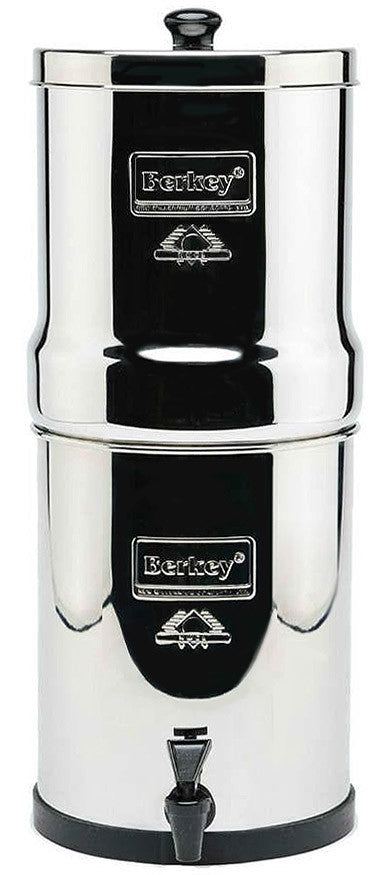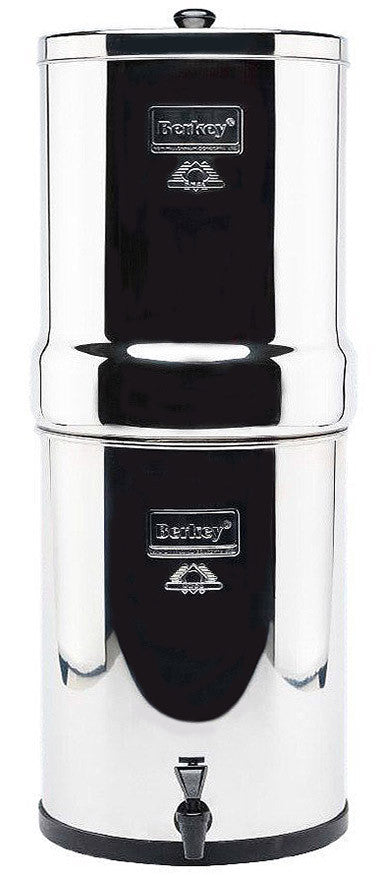
Chlorine is undoubtedly the most commonly used drinking water disinfectant worldwide. This halogen element has provided safe drinking water in the United States for over 100 years.
Starting September 26, 1908, Jersey City, New Jersey, became the first U.S. city to routinely chlorinate its drinking water supply. Over a thousand U.S. urban communities adopted chlorination throughout the following decade, resulting in a drastic reduction in the incidence of infectious diseases.
Today, around 98 percent of U.S. water treatment systems use chlorine purification to provide safe drinking water. The U.S. Ecological Protection Agency (EPA) requires treated tap water to contain a detectable chlorine level to shield against germs as it flows from the treatment plant to customers' taps.
Chlorination is a water treatment method. Be that as it may, is it safe?
You have sniffed chlorine at the pool and your tap. It's a water disinfectant widely used. Yet, why? Furthermore, have you poured a glass and then stopped yourself from taking a sip at any point?
Let’s delve into chlorine as a water treatment, its harmful effects, and how to protect against its cons.
Why is Chlorine added to drinking water?
Chlorine eradicates disease-causing germs and helps make water safe to drink. Waterborne illnesses once consistently affected a large number of U.S. residents.
Following its first use in 1908 in Jersey City, New Jersey, the practice of drinking water chlorination spread rapidly throughout the United States. It served its purpose and helped prevent waterborne illnesses, such as cholera and typhoid fever.
Drinking water chlorination impressively expanded Americans' future by 50 percent in the twentieth century. The U.S. Centers for Disease Control and Prevention (CDC) calls it "a standout among the most significant public health discoveries in U.S. history."
In addition to destroying harmful germs, such as bacteria, infections, and parasites, chlorine also reduces repulsive tastes and odors in water.
Chlorine disposes of slime, microscopic organisms, molds, and algae that usually develop in water supply wells, springs, on the dividers of water mains, and storage tanks.
The U.S. Environmental Protection Agency (EPA) requires treated tap water to contain a different chlorine level to help protect against germs throughout the residents’ taps.
You Should Measure High Levels of Chlorine
Even though chlorine is fundamental and safe in ample amounts, you should check the chlorine levels in your drinking water to ensure the safety of yourself and your family. The EPA advises that levels exceeding the regulated limit are dangerous.
The agency’s councils state that reasonable chlorine levels in drinking water may be up to 4 parts per million. This provision provides ample room for error, so if larger amounts of chlorine are erroneously included, most consumers will still be protected. At the same time, action is taken to redress the mistake.
It's worth noting that water treatment facilities are responsible for testing your water. However, they don't generally test often or precisely. The frequency of testing is directly linked to the quality of raw water and the number of consumers.
If you live in a densely populated region with low-quality drinking water at its sources, your water is likely to be tested daily.
However, if you live in an area with top-notch mountain spring water and fewer than 10,000 residents, your water might be tested as often as once a month.
Chlorine in your drinking water is harming your health and your family.

Treating drinking water before it is transported to your home is critical. Initial wide chlorination of drinking water led to widespread contamination and posed a greater health hazard than chlorine.
That said, chlorine is far from healthy. Over time, as we are exposed to chlorine, it builds up in the body and disrupts the well-being of our cells and organs.
Subsequently, we are at greater risk of developing threatening infections.
Chlorine Can Gain Weight
Drinking or showering in chlorinated water can affect weight gain in a few ways. As a harmful substance, chlorine removes the iodine in your thyroid, prompting hypothyroidism and undesirable symptoms like hot flashes and weight gain.
Moreover, because your liver is busy producing extra estrogen, it is less able to perform other vital functions, such as burning fat.
Chlorine likewise kills cell reinforcements, such as vitamins E and A, that regularly protect your good fats from harm. Without this defense, you can end up with insufficient amounts of good fats like omega-3, 6, and 9, which can lead to more weight gain!
Chlorine Can Mimic Estrogen
What's worse is the hormonal disruption chlorine causes in your body, whether it is absorbed through your skin in the shower or from drinking water. When it's in our bodies, chlorine can act as a xenoestrogen (or false estrogen).
Xenoestrogens add to estrogen strength, resulting in both female and male cancers and many other health concerns like male pattern baldness, weariness, reduced sex drive, hypothyroidism, hypoglycemia, a sleeping disorder, and PMS. It also prompts nutrient deficiencies, such as zinc, magnesium, and B vitamins (which are associated with a long list of health issues).
Chlorine Can Kill Good Gut Bacteria
Bacteria in our drinking water have become more intelligent. Many waterborne parasites, like Giardia and Cryptosporidium, once alerted by chlorination, have developed resistance to chlorine, leading to other levels of protection that have been significantly less successful.
Chlorine is a disinfectant intended to kill bacteria in water. Its absorption action penetrates the GI tract, wiping out beneficial gut microbes such as Lactobacillus. Without these beneficial bacteria, the immune system suffers, and numerous investigations have now connected poor gut health to emotional well-being issues in youngsters.
A recent study found a relationship between disposition and the presence of beneficial bacteria, despite indicating poor gut health, which is linked to ailments such as asthma, bowel disease, obesity, and hypersensitivity.
To keep your gut unstable, avoid chlorine in your drinking water and use a brilliant probiotic powder containing around 10 billion beneficial bacteria daily. Populating your GI tract with probiotics can help prevent bacteria and parasites (waterborne or otherwise), yeast overgrowth, and hypersensitivity.
And that is not all.
As chlorine reacts with water-soluble organic compounds, it poses significantly more serious concerns for our well-being. Disinfectant By-Products (DBPs) like trihalomethanes (THMs) and haloacetic acids (HAAs) are linked to reproductive issues, including stillbirths in animals and people, and pose a significant hazard through skin exposure from pools and showers, even in your drinking water.
One type of THMs is chloroform—the chemical used to thump people out—so it shouldn't seem to be a stretch when we say exposing yourself consistently to chlorine can cause harm to the kidney, liver, and nervous system!
Should You Stop Drinking Chlorinated Water?
Every passing incident caused by something we hope to be protected from, such as our drinking water, is one of many. Yet, there are no substantial alternative water treatment options available. To stop chlorinating our drinking water isn't an alternative, as it became clear in Latin America two decades ago.
The significance of security against harmful waterborne diseases was demonstrated in Peru in 1991 when a lack of drinking water sterilization led to a five-year cholera outbreak. The plague spread to 19 nations, killing 12,000 people and infecting over one million people.
How could this occur? There was a misinterpretation of the health risks posed by chlorination byproducts. Since these risks were believed to be substantially higher than they are, several communities and districts in Latin America chose to abandon chlorination.
To prevent further misconstruction, the EPA stated that, given the advantages of disinfection, as evidenced by reduced waterborne disease outbreaks and hypothetical excess cancer risk, the EPA emphatically supports disinfecting drinking water to control bacteria.
What You Can Do To Protect Yourself and Your Family

While water treatment options like ultraviolet and ozone exist, chlorine plays a "fundamental" role in drinking water that the vast majority of Americans aren't ready to avoid.
However, a basic filter in your home is necessary to protect your family from chlorine and its harmful effects. A premium filter can remove over 99% of chlorine and 95% of chloramines, chloroform, and byproducts like THMs.
Now that we have been exposed to chlorination byproducts for a long time, it is advisable to make a move.
The water might be filtered and treated at the plant; however, when it reaches your home, it may not be perfect, with the potential for contamination from other buyers, old, dirty funnels, and so on.
Boiling water will expel chlorine. However, it will just filter a few results.
After boiling, trihalomethane concentrations decreased in chloraminated (74-98%) and chlorinated (64-98%) water. Boiling chlorinated water for 1 minute lessened chloroform concentration by 75%. Chloroform was decreased by 34% in chlorinated water following a 1-minute boil.
High-quality carbon block filters are the best for removing DBPs. The EPA also recommends them as the best alternative for expelling synthetic substances, herbicides, pesticides, microbes, VOCs, fluoride (with filter connection), heavy metals, nitrates, nitrites, and parasites.
So, ensure your tap water is drinkable with an under-the-counter or countertop filter. This filter will eliminate chlorine and its byproducts and protect your family from parasites and heavy metals like lead.
Installing sufficient water filtration in your home is the most secure and cost-effective way to remove chlorine and enjoy clean water for cooking, drinking, washing, and showering.
Berkey Water Filters can remove chlorine for greater than 99.9%.
Berkey Water Filters can remove
-
Fluoride - Removed to greater than 99.9%.
-
Lead - Removed to greater than 99.9%.
-
Arsenic - Removed to greater than 99.9%.
-
Iron - Removed to greater than 99.9%.
-
Mercury - Removed to greater than 99.9%.
-
Chlorine - Removed to greater than 99.9%.
-
Trihalomethane(THMs) – Removed to greater than 99.8%.
-
Bisphenol-A - Removed to greater than 99.9%.
-
Chloramines - Removed to greater than 99.9%.
-
Pharmaceuticals - Removed to greater than 99.5%.
-
Petroleum Contaminants - Removed to greater than 99.9%.
-
Methylcyclohexane-methane - Removed to greater than 99.9%.
-
Pesticides - Removed to greater than 99.9%.
-
Heavy Metals - Removed to greater than 99.1%.
-
Atrazine - Removed to greater than 99.9%.
-
Uranium - Removed to greater than 97.0%.
-
Gross Alpha emitters - Removed to greater than 98.7%.
State and EPA-accredited laboratories have tested the filter formulation of Berkey systems (Black Berkey Purification Element) to exceed NSF/ANSI Standard 53.
In lieu of Black Berkey® Elements Replacement Filters, use the new Phoenix Gravity New Millennium Edition Filters.
Also Read: Is It Safe To Drink Tap Water In U.S.? Find Out The Facts And Truth About Tap Water
← Older Post Newer Post →





